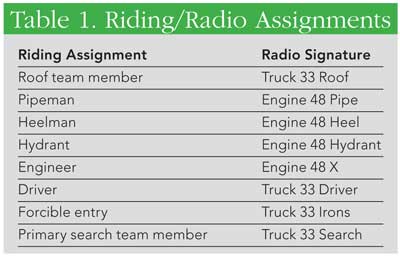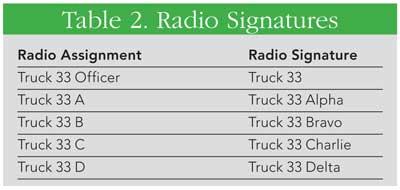BY GERALD L. HUGHES
At 0800 roll call, Engine 48’s members fall in to confirm riding assignments, conduct morning self-contained breathing apparatus (SCBA) checks, and discuss all pertinent information received from fire department headquarters from the previous shifts. With respect to riding assignments, the company officer asks that each member speak up to let the group know what riding assignment they are taking so everyone knows who is doing what when a fire call comes in. After a brief pause, one after the other calls out his riding assignment and radio signature (Table 1).

The engine and truck officers nod approvingly and continue with the SCBA drill. The tour of duty has officially begun, and the teams that will work together for the next 24 hours have been established. Team members have acknowledged their riding assignments in front of all other team members and supervisors. At a very basic team level, this is how a fire company is assembled; but in today’s modern fire service, it is not always the way a fire company goes to work.
In the past, when all a fire company did was put out fires, the traditional company roles and riding assignments also designated its radio signatures. However, the demands of emergency response in the 21st century fire service require firefighters to perform a multitude of tasks on the scene.
In many fire departments throughout the United States, a recent effort to equip all first responders with digital two-way radios has come to fruition. When implemented successfully, such improvements can provide added safety and reliability. Some firefighters, however, are already saying that having more radios at the fire scene creates too much radio traffic and makes operations more difficult than they were in the past. Veteran battalion chiefs have stated that every time the alarm level at an emergency scene is elevated, it brings in more radios, further complicating an already difficult incident with increased radio traffic. In some jurisdictions, every firefighter at the emergency scene has a radio. Although this is a blessing for a firefighter in distress who is broadcasting a Mayday, it can be a curse if radio discipline breaks down and a communication collapse occurs.
The National Institute for Occupational Safety and Health has recognized that when a serious injury or a line-of-duty death (LODD) occurs, the lack of having or observing effective written standard operating guidelines or procedures (SOGs/SOPs) was often the basis for poor performance that led to a firefighter injury or death. The fire service is often forced to confront a tragedy before developing a new policy to prevent a similar occurrence in the future. The fire service culture is moving toward a more focused and proactive approach to preventing death and injury to firefighters and civilians. For example, the National Fallen Firefighters Foundation has developed the “Everyone Goes Home” campaign, designed to reduce firefighter LODDs by focusing on training that increases situational awareness. Additional radios for first responders is the kind of change that could enhance situational awareness. When effective, radios can improve tactical discipline at emergency incidents, making the scene safer for everyone.
| Figure 1. Still Alarm, High-Rise: First Truck Assignments/Tools |
 |
Radio Signatures
The lack of preassigned, uniform radio signatures for all on-duty firefighters is what is missing to effectively identify all personnel operating at an emergency scene. All members on scene should be able to immediately identify the radio signatures they hear over their portable radios. “Truck 33 Irons,” used to raise the forcible entry team member on the tactical channel, may sound unreadable because the word “irons” may sound similar to other words such as “wires,” “tires,” or “fires.” The NATO Phonetic Alphabet or, more accurately, the International Radiotelephony Spelling Alphabet, is the phonetic spelling alphabet most widely used by those who transmit and receive voice messages by radio or telephone. To provide clear radio transmissions, the International Civil Aviation Organization (ICAO) assigned code words acrophonically to the letters of the English alphabet so that critical word combinations of letters and numbers could be pronounced and understood by those who transmit and receive voice messages by radio or telephone regardless of their native language or the presence of transmission static. Instituting a national standard for a uniform radio signature designation system to identify fire service first responders could improve emergency radio transmissions and enhance multijurisdictional interoperability.

Each morning, when firefighters report for duty, they sign for three important pieces of equipment: their SCBA, their flashlight, and their radio. Each radio is engraved with a number/letter designation (e.g., TRK-33, TRK-33A, TRK-33B, etc.). To easily assign a suitable radio signature for each member, assign the same number/letter designation engraved on the radio to each member using an alphanumeric signature.
Using the NATO Phonetic Alphabet to clearly acknowledge each radio user on the tactical channel would make radio communications simple so that each member’s signature is distinct enough from another to avoid confusion.
Saying “Battalion 25 to Truck 33 Charlie” is more radio readable and person/name specific compared to the tool/task specific signature “Truck 33 Irons.” Designating a team member’s radio signature according to the tool or the task gets confusing if that member is reassigned to another task. When this happens, a firefighter may assume that he no longer has to answer calls for his previous assignment, and so he may not acknowledge radio transmissions made to him.
| Figure 2. Still Alarm, Nonhigh-Rise: RIT Truck Assignments/Tools |
 |
Uniform Fire Terminology
The fire service needs to develop a national standard for fire service terminology to avoid radio communication breakdowns. Different jurisdictions may use different fire service terminology for the same objective. An emergency may require that a fire unit respond outside of its jurisdiction to aid a neighboring fire department. The outside responding units may be assigned the duties of rapid intervention team (RIT). Procedurally, the fire department responding as RIT needs to communicate effectively with the other fire department to support an effective outcome-especially when firefighters’ lives are on the line. Having digital radios to communicate with each other is of no use if the users can’t communicate because of a “language” barrier. If a visiting fire department designates sectors as “Side A, B, C, D” and responds to a RIT call in another jurisdiction that uses numerical designations “Side 1, 2, 3, 4,” communication may break down, causing a delay that could jeopardize the mission to rescue a firefighter in distress.
Emergency Response Tag (ERT) System. Each time a fire unit is dispatched, the individual firefighter’s job duties change depending on the specific alarm assignment generated from the 911 call center. Compare, for example, how the job duties change for the members assigned to Truck 33 when responding to a still alarm in a high-rise vs. a RIT assignment at a residential house fire.
Now consider that each team member’s specific job duties could be broken down based on alarm assignment and specific radio signature-Alpha, Bravo, Charlie, or Delta. The job duties for each member are delineated for each specific alarm assignment and documented on a series of laminated 4¼- × 11-inch ERTs that can be tethered by a lanyard to each firefighter’s jump seat on the apparatus. By referencing the ERTs en route to an alarm, coupled with training on the actual information contained within each ERT, firefighters can enhance their situational awareness and experience more effective outcomes at the scene of every kind of emergency incident to which they respond.
A complete set of ERTs for each specific type of apparatus and associated alarm assignments can be customized to suit the needs of any fire department. Firefighters train on their job assignments as a group, keeping in mind that at any given moment, their ERT assignments may change as directed by the company officer or other ranking officer.
A national uniform radio signature system will improve emergency radio transmissions and enhance multijurisdictional interoperability.
GERALD L. HUGHES is a 26-year veteran of and captain/emergency medical technician B with the Chicago (IL) Fire Department, supervising Truck 33 on the South Side. He was lead supervisor for the Court Code Enforcement Section in the Bureau of Fire Prevention.
Fire Engineering Archives

